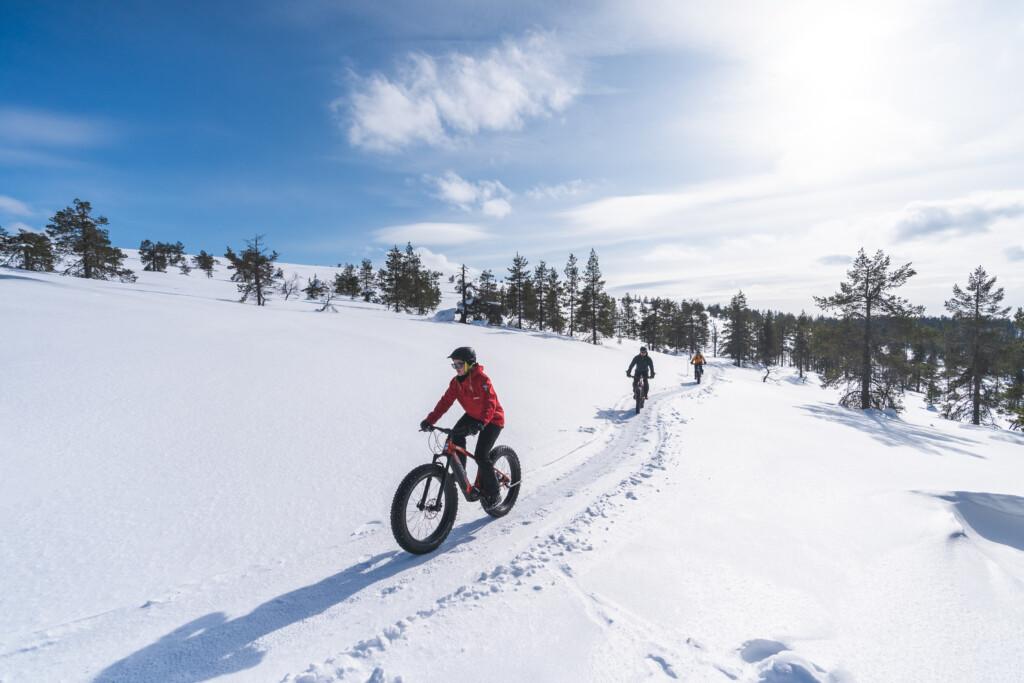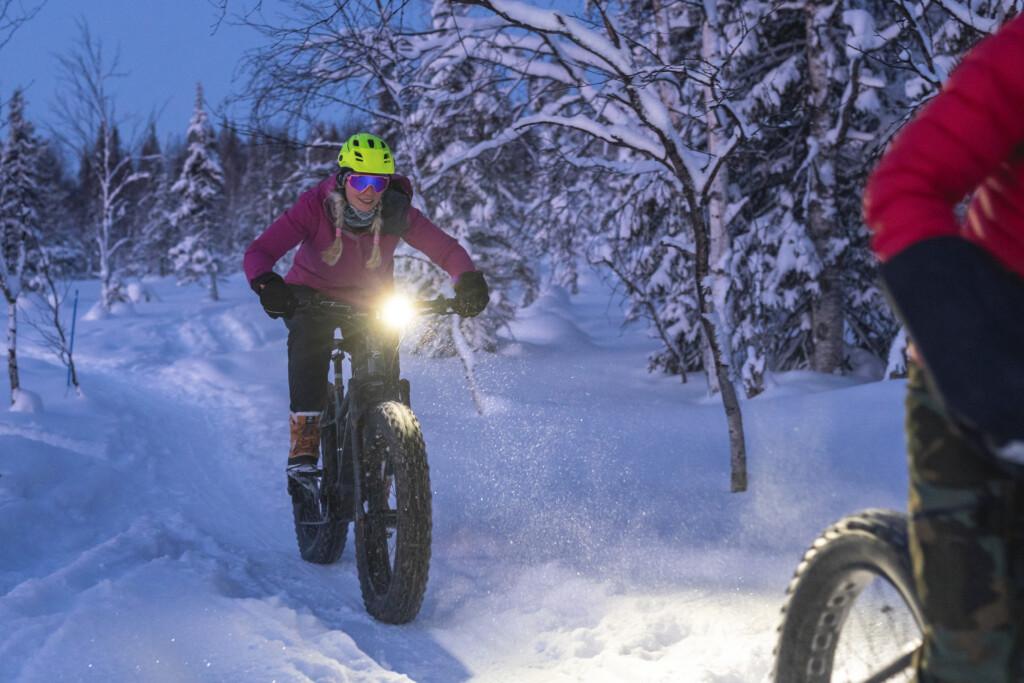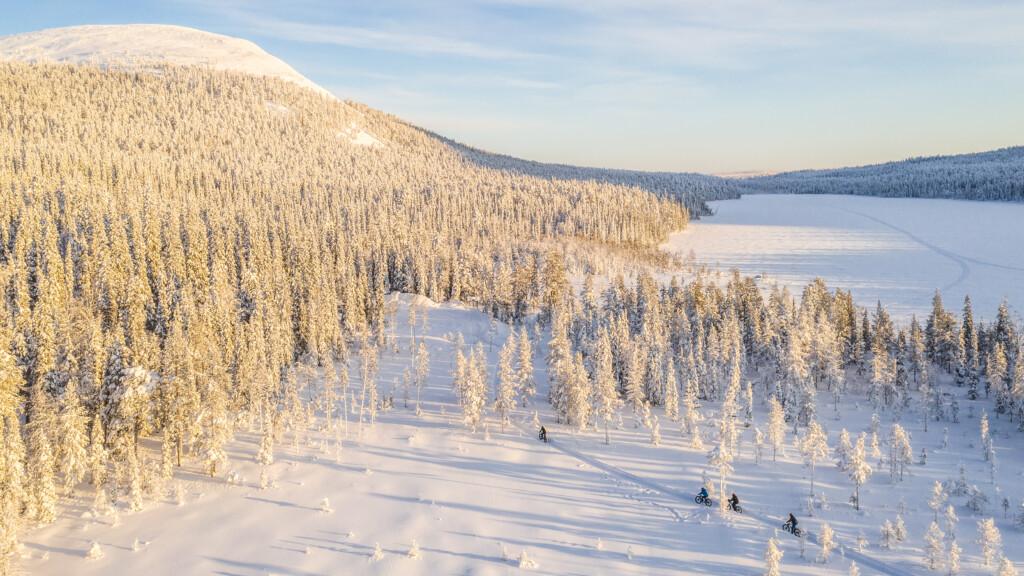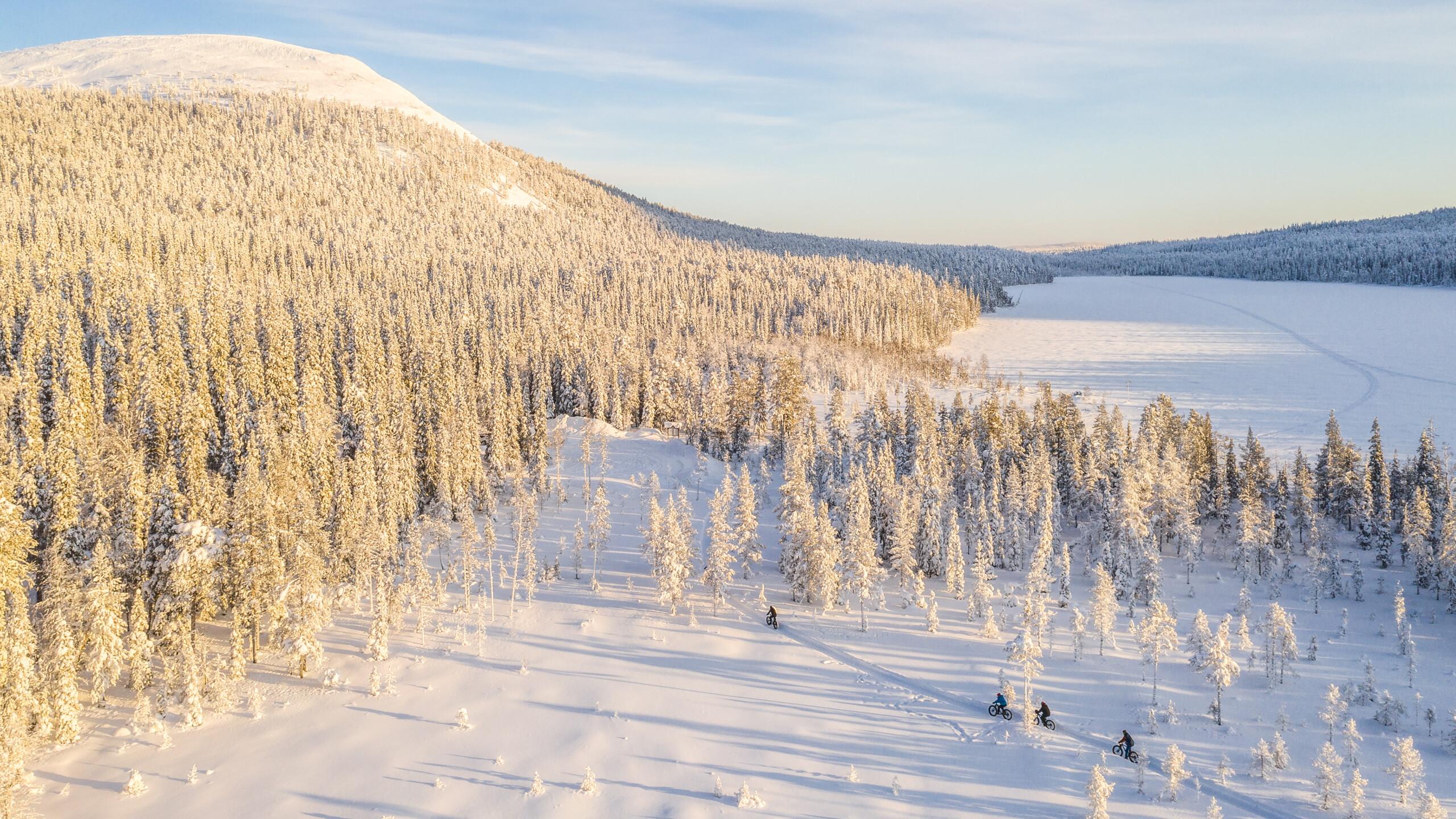Winter biking opportunities in Ylläs are unparalleled, with maintained winter trails offering varied terrain for cyclists. Would you like to try winter biking in Ylläs, but perhaps some practical matter is still on your mind? The article covers, among other things, what is required from the bike on winter trails and what factors make up the right route choice.
Cycling on Ylläs winter trails
The winter trail network in Ylläs is extensive – 100 kilometers of maintained winter trails for walkers and cyclists in some of the most memorable landscapes. Winter cycling is a quiet and environmentally friendly way to enjoy nature.
In winter cycling, it is good to consider some factors to get the most out of the experience and make cycling enjoyable. Successful winter cycling also places certain demands on equipment and gear.

The right equipment for winter biking
A suitable bike for winter trails is a fatbike. The wide tires of a fatbike provide the best support on snowy trails and do not damage the path for other users. Additionally, wide tires offer better traction on snowy trails and make riding more stable. Ylläs rental shops provide expert service and the right gear for a winter biking trip.
The narrow tires and high tire pressure of a regular bike can leave very deep and unpleasant ruts in the trail for a long time. These ruts may not even be corrected during the next trail maintenance. It is also good to check the tire pressure on a fatbike to ensure it is sufficiently low.
Suitable tire pressure depends on the rider’s weight and snow conditions. Too high tire pressure also reduces the grip of a fatbike and ruins the trail for subsequent users. Cycling with too high pressure is also much heavier as the surface constantly breaks under the tires. Rental shops usually take care of this for their own bikes, but you can always ask about it before heading to the trails.
Fatbikes are available in all rental shops with electric assistance, which makes longer rides easier and slightly lightens the riding experience. You can still work up a sweat while cycling if you wish. Electric assistance also allows beginners to take longer rides.
Equipment
For a successful cycling trip, you need at least winter clothing suitable for the conditions, warm shoes suitable for cycling, and of course, the previously mentioned wide-tire bike suitable for winter trails, as well as a cycling helmet. It’s good to pack a backpack with warm clothes for breaks, small snacks, and drinks.
Pack at least these items for a self-guided winter biking trip:
- Winter clothing suitable for physical activity
- Warm shoes
- Thick mittens
- Backpack
- Drinks
- Small snacks
- Clothes for breaks
- Headlamp
- Map and phone
- Cycling helmet
- Sunglasses or ski goggles

Conditions
When conditions are at their best, cycling on winter trails is easy and effortless. The trails are smoother compared to many summer trails, making cycling easier even for beginners. During cold spells and later in the spring when the snow hardens, the trails become firmer and easier to ride. After snowfall, the trails are softer and more challenging, and thus always heavier to ride. Check the weather before heading out to cycle.
Trail maintenance
Winter trails are maintained regularly, mainly in the evenings and nights, so the surface has time to harden before the next users. If a lot of soft new snow has fallen, it may take longer for the trail to harden. In the spring, warming weather also softens the trail surface. During soft conditions, it is especially important to ensure low tire pressure. You can find maintained trails, route recommendations, and wilderness cafes on Ylläs’ digital map.
Cycling in cold weather
Pack warm clothes for breaks and, for example, spare gloves. After a break, damp gloves can feel very cold. The temperature limit for electric-assisted bikes is around -20°C, as colder temperatures can cause problems with the battery.
In cold weather, it is best to choose shoes with thicker soles that are roomy enough for thick wool socks. Gloves should be as warm as possible. During severe cold, it is important to ensure appropriate and adjustable clothing, as sweat-soaked clothes can be dangerous in the cold. Reduce clothing in your backpack in time before it gets too hot.
In freezing weather, it is good to have spare clothes with you in case of a bike problem or injury. Plan your route so that you can warm up at regular intervals if necessary. Remember to turn back in time if you feel the cold is biting too hard.
Route choices
Winter biking routes are marked at intersections with blue signs featuring a blue cyclist image. Additionally, there are smaller blue poles along the routes. All maintained and serviced winter trails in Ylläs are intended for both walkers and cyclists. You might even encounter someone on sliding snowshoes. Snowshoe trails, on the other hand, are not suitable for cycling as they are not maintained at all. In some route intersections or, for example, river crossings, all routes briefly follow a so-called shared trail. In this case, everyone, regardless of their mode of travel, uses the same route. Cycling is not allowed on Ylläs ski trails.
Some winter trails run lower at the village level, and later in the season, routes such as the winter trail to Tunturijärvi or Kukastunturi rise higher, offering the rider beautiful changing landscapes. Trails through forests and open marsh areas provide the best taste of the area’s diverse nature, offering views of the surrounding fells.

Route recommendations
The best routes for winter biking depend on many factors, such as experience level, weather, and what you want to see and experience. Here are some tips to help you choose the right route.
Experience level
Beginners should choose shorter and flatter routes, such as the trail to Kesänkijärvi or the trail from Ylläs Ski Resort Ylläsjärvi towards Ojanlatva lean-to. More experienced cyclists can try longer and more challenging routes, such as the Kukastunturi winter biking route.
Weather conditions
On cold days and in strong winds, it is advisable to choose routes that run through more forested areas, as the trees provide shelter for the cyclist. After snowfall, it is best to avoid unmaintained and too soft routes. Ylläs’ digital map helps you track the current maintenance status. After snowy days, it takes a while for the trails to harden to their best condition. In spring, when the snow hardens, the trails are often as hard as concrete, making cycling easy and fast.
Scenery
If you are interested in fell landscapes, choose routes that run higher, such as the winter trail to Tunturijärvi. Trails through forests offer a peaceful and beautiful environment for cycling, and you might even catch a glimpse of a Siberian jay.
Guided tours
A great way to outsource planning and thoughts on the best route choices for the day is to book a guided winter biking tour. There are several companies in the area that offer professional guidance in the sport. A guide can tailor the day’s plan to the weather and the cyclists’ level in the best possible way. The community aspect of guided tours adds joy and safety to cycling.

What to consider?
Always be mindful of other trail users on narrow paths. Winter trails can also be used for walking, and many walkers have pets with them. Cyclists should always yield to other users. Signal your approach with sound to avoid startling walkers unnecessarily. A cheerful greeting and thanks when another user steps aside spread good vibes.
Do not cycle on the ski trails.
If you are a beginner – start with shorter routes. Initially, choose shorter and easier routes to get accustomed to cycling in the snow.
During the polar night, you will need a headlight or headlamp that you can attach to your helmet. Even as the days get longer, it can be good to keep it with you just in case.
Dress in layers. Layered clothing helps regulate temperature and keeps you dry and warm. Also, remember to bring clothes for breaks.
Consider the effect of cold weather on the battery of an electric bike in severe cold.
Enjoy the winter cycling experience in Ylläs
Winter biking in Ylläs is the perfect way to combine exercise and nature appreciation. Remember to consider the weather conditions, equip yourself properly, and respect other trail users. Whether you are a first-timer or an experienced cyclist, you will surely find a route that suits you. The diverse trails and breathtaking landscapes of Ylläs await you. Winter biking in Ylläs is an experience you won’t forget!
